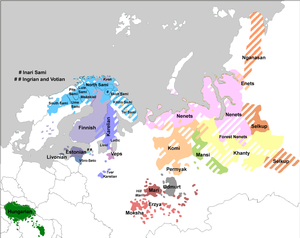모르드비어족
Mordvinic languages| 모르드비니치 | |
|---|---|
| 민족성 | 모르드빈스 |
| 지리적 분배 | 러시아 남서부 및 남동부 |
| 언어분류 | 우랄어
|
| 소분할 | |
| 글로톨로그 | mord1256 |
The Mordvinic languages,[1] also known as the Mordvin,[2] Mordovian or Mordvinian languages (Russian: мордовские языки, mordovskiye yazyki),[3] are a subgroup of the Uralic languages, comprising the closely related Erzya language and Moksha language, both spoken in Mordovia.[4]
이전에는 단일 "모르드빈 언어"[5]로 여겨지던 것이 이제는 [6]작은 언어 그룹으로 취급된다.음운론, 어휘, 문법의 차이로 인해 에르자와 목샤는 서로 이해할 [7]수 없다.두 모르드비니어 언어도 별개의 문학적 형태를 가지고 있다.에르자 문어는 1922년에, 목산은 [8]1923년에 만들어졌다.
두 언어 사이의 음운학적 차이는 다음과 같습니다.[5]
- Moksha는 Erzya에서 /e/로 병합되는 동안 /e/모음을 구별한다.
- 강세가 없는 음절에서 에르자어는 다른 우랄어족 언어들처럼 모음 조화가 특징이며, 앞-보컬 단어에서는 [e], 뒷-보컬 단어에서는 [o]를 사용한다.목사는 그 자리에 간단한 스콰가 있다.
- 처음에, Erzya는 Moksha에서 마찰음 /θ/에 대응하는 우편 파찰음 /tθ/를 가진다.
- 무성 자음 옆에는 액체 /r, r l, l, l and/와 반음 /j/가 목사에서 [r r rʲ l̥ l̥ l̥ l̥ ]로 분리된다.
중세 메쉬케리아어는 모르드비어이거나 모르드비어에[citation needed] 가까웠을 것이다.
분류
전통적으로 우랄어파는 몰드비어와 마리어를 우랄어족의 볼가이어파로 분류했지만 20세기 [9]후반에 이 관점은 사라졌다.대신, 일부 우랄학자들은 현재 우랄어족의 [10][11][12]9가지 주요 분기 중 하나로 모르드비니어를 우랄어족의 핀어족과 사아믹어족과의 밀접한 관계를 주장하는 빠른 확장 모델을 선호한다.
레퍼런스
- ^ Bright, William (1992). International Encyclopedia of Linguistics. Oxford University Press. ISBN 978-0-19-505196-4.
- ^ 모르드빈어 @ 구글북스
- ^ Dalby, Andrew (1998). Dictionary of Languages. Columbia University Press. p. 429.
Erza.
- ^ Grenoble, Lenore (2003). Language Policy in the Soviet Union. Springer. p. A80. ISBN 978-1-4020-1298-3.
- ^ a b Raun, Alo (1988). Sinor, Denis (ed.). The Uralic languages: Description, history and foreign influences. BRILL. p. A96. ISBN 978-90-04-07741-6.
- ^ Hamari, Arja; Ajanki, Rigina (2022). "Mordvin (Erzya and Moksha)". In Marianne Bakró-Nagy; Johanna Laakso; Elena Skribnik (eds.). The Oxford Guide to the Uralic Languages. Oxford University Press. pp. 392–431.
- ^ Феоктистов А. П. Мордовские языки.основы финно-угорского языкознания.,,,,,,,,,,,,,,,,,,,,,,,,,,,,,,,,,,,,,,,,,,,,,,,,,,,,,.
- ^ Wixman, Ronald (1984). The Peoples of the USSR. M.E. Sharpe. p. A137. ISBN 978-0-87332-506-6.
- ^ Abondolo, Daniel (1988). The Uralic Languages. London & New York: Routledge. p. 4.
[...] the idea, once widely-held, that there was a common Mordva-Mari protolanguage (so-called 'proto-Volgaic') is now out of favour.
- ^ Nichols, Johanna (2021). "The Origin and Dispersal of Uralic: Distributional Typological View". Annual Review of Linguistics. 7: 351–369. doi:10.1146/annurev-linguistics-011619-030405.
- ^ Saarikivi, Janne (2022). "The divergence of Proto-Uralic and its offspring: A descendant reconstruction". In Marianne Bakró-Nagy; Johanna Laakso; Elena Skribnik (eds.). The Oxford Guide to the Uralic Languages. Oxford University Press. pp. 28–58.
- ^ Piispanen, Peter S. (2016). "Statistical Dating of Finno-Mordvinic Languages through Comparative Linguistics and Sound Laws" (PDF). Fenno-Ugrica Suecana Nova Series. 15: 1–58.



